Wild cats, belonging to the Felidae family, are some of the most agile and skilled predators on the planet. While domestic cats are often known for their aversion to water, many wild cat species thrive in aquatic environments. Some wild cats are not only capable swimmers but actually rely on water for various activities like hunting, cooling off, and even crossing territories. This comprehensive guide will explore 15 wild cats that are proficient swimmers, from the mighty tigers to the elusive small wild cats like the leopard cat and fishing cat.
Big cats are the largest members of the Felidae family. Many of these large wild cats have evolved to be skilled swimmers, often using water for both hunting and travel. Here are some of the most prominent big cats that are capable swimmers.
Tigers are one of the best swimmers among the big cats. Native to the jungles of southern Asia, China, and eastern Russia, tigers often inhabit areas near rivers, lakes, and wetlands. Their strong, muscular bodies and webbed paws allow them to swim long distances, sometimes for miles. Tigers are known to swim across islands or rivers in search of food, territory, or to escape threats. They also hunt in the water, preying on fish, crocodiles, and other aquatic creatures.
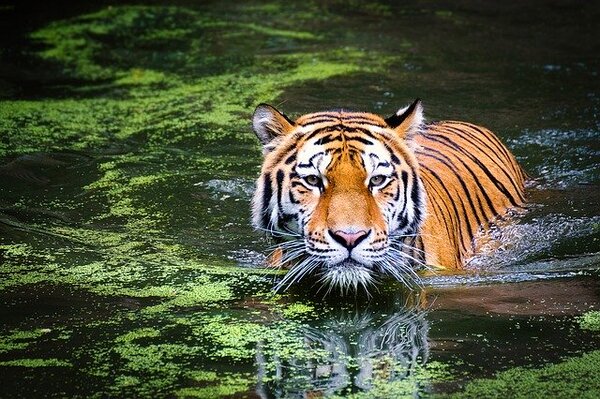
Tigers range from 6 to 10 feet in length and can weigh anywhere from 220 to over 600 lbs. Their swimming ability makes them one of the most adaptable predators in the wild.
Jaguars, found across 19 countries in the Americas, are incredibly adept swimmers. These big cats live in rainforests and wetlands, where they frequently hunt in and around water. Jaguars have webbed paws that make them excellent swimmers, and they are known for diving into the water to catch prey like fish, caimans, turtles, and even small alligators. Jaguars have been observed swimming across rivers and lakes in their habitat.
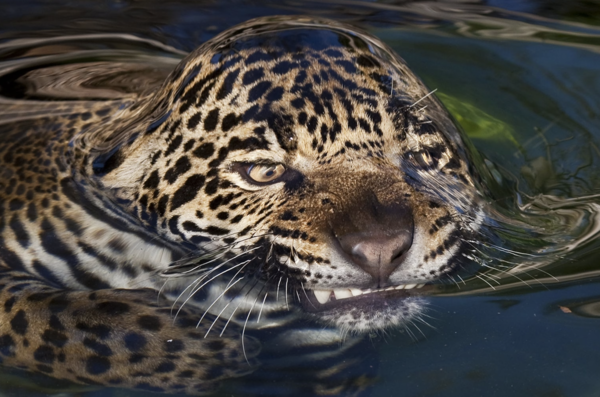
Jaguars can grow from 5 to 8 feet long and weigh between 80 and 350 lbs. Their incredible swimming skills are an important aspect of their hunting and survival tactics.
Leopards are also proficient swimmers. While they are not as aquatic as tigers or jaguars, leopards are often found near water sources like rivers and lakes. Leopards are capable of crossing rivers and can hunt in the water, sometimes targeting fish and crabs. Leopards are known to be opportunistic hunters and will take advantage of aquatic environments when available.
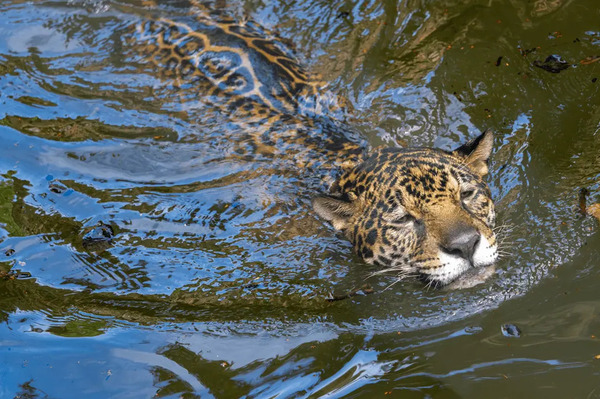
Leopards typically range from 36 to 72 inches in length, with large paws that help them swim effectively across water when needed.
Lions are not generally known for their fondness of water, but they will occasionally swim to cross rivers and streams when necessary. While they are mostly found in Africa, with a small population in India, lions have been seen swimming across rivers to expand their territories or avoid threats. Although not habitual swimmers, lions are capable of swimming when required.
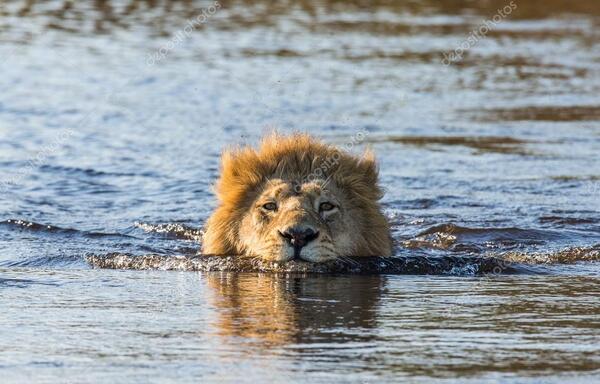
Male lions range from 5.6 to 8.3 feet in length and weigh between 330 and 570 lbs.
Cheetahs are not fond of water, but they will occasionally swim if necessary, particularly when crossing rivers or streams. Their primary skill lies in running at incredible speeds, but if water becomes an obstacle, they will swim across it. Cheetahs can be found across Africa and parts of Iran. Males typically measure around 3.5 to 5 feet in length and weigh between 50 and 160 lbs.
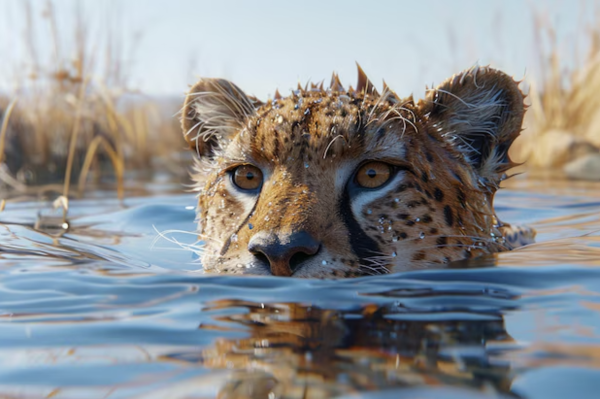
Medium-sized wild cats are generally twice the size of a domestic cat and are often skilled swimmers. Many of these cats are frequently found in aquatic environments, where they rely on their swimming ability for hunting and travel.
Clouded leopards, found in the rainforests of the Himalayas, Southeast Asia, and South China, are not only skilled swimmers but also excellent climbers. These cats are often found near rivers, streams, and other water sources. They use their swimming skills to navigate across rivers and hunt for aquatic prey. The clouded leopard is also an expert climber, which adds to its ability to adapt to diverse environments.
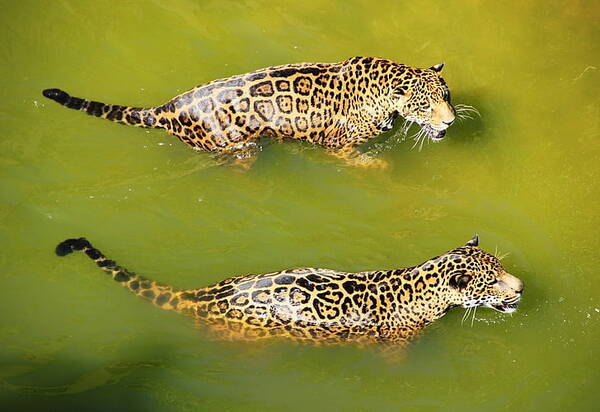
Clouded leopards range from 26 to 41 inches in length, and their swimming abilities help them thrive in their water-rich habitats.
The fishing cat is one of the most well-known wild cat swimmers. Native to Southeast Asia, fishing cats are highly adapted to wetland environments, where they hunt for fish, frogs, and other small aquatic creatures. Their partially webbed paws make them excellent swimmers, and they are known to dive underwater to catch their prey. Fishing cats are typically found in marshes, swamps, and riverbeds.
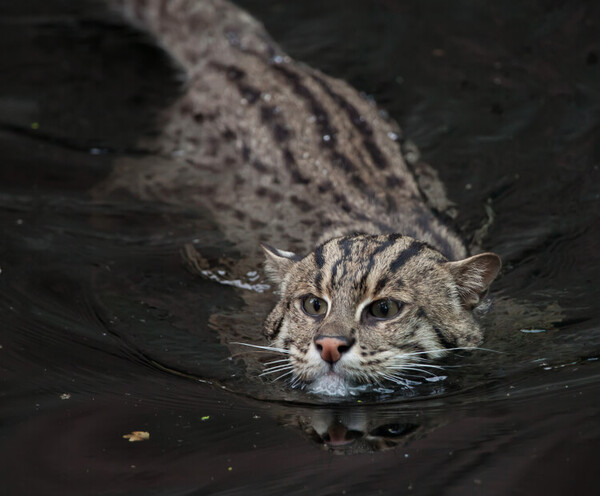
Fishing cats typically range from 33 to 45 inches in length and are skilled swimmers who spend a lot of time in the water hunting.
The jaguarundi, also known as the otter cat, is another skilled swimmer. Found in Central and South America, the jaguarundi is often found near rivers, lakes, and wetlands, where it hunts for fish, amphibians, and small mammals. Jaguarundis are secretive, solitary cats, but they are known for their strong swimming abilities. They can often be seen diving into the water to catch prey.
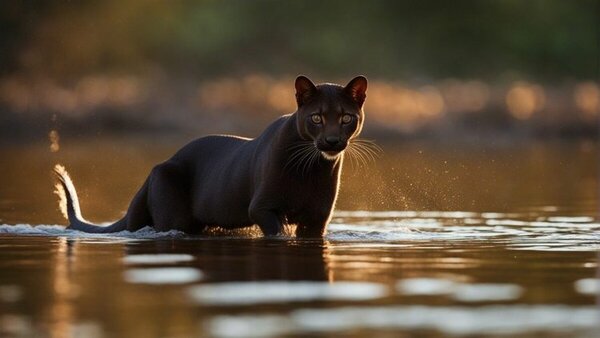
Jaguarundis typically range from 21 to 30 inches in length, with their tail length ranging from 12 to 20 inches.
Ocelots, native to Central and South America, are medium-sized wild cats that are proficient swimmers. These cats are often found near water sources like rivers, lakes, and marshes, where they hunt for fish, frogs, and other aquatic animals. Ocelots are not only skilled swimmers but are also known for their agility, which makes them effective hunters in water.
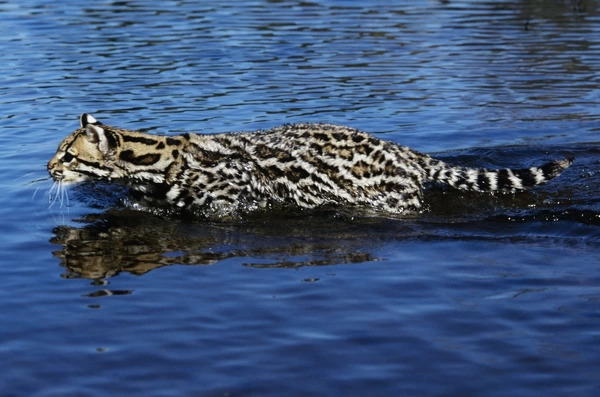
Ocelots typically range from 29 to 39 inches in length and are often seen swimming in rivers or lakes to catch prey.
Servals are found throughout sub-Saharan Africa and are skilled swimmers. They are often found in wetland areas where they hunt for frogs, birds, and small mammals. While they are more known for their jumping abilities (they can leap up to 10 feet in the air), servals are also proficient swimmers and will dive into the water to catch prey.
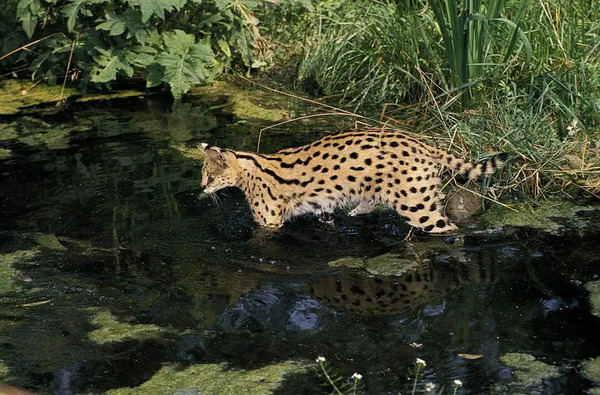
Servals are typically between 21 and 24 inches tall and can range in length from 39 to 51 inches.
Small wild cats, typically around the size of a domestic cat, also exhibit remarkable swimming skills. These cats are often found near water and use their swimming abilities to hunt and navigate through aquatic environments.
The flat-headed cat is a small wild cat closely related to the fishing cat and is found in Southeast Asia, particularly on the Thai-Malay Peninsula and Borneo. These cats are excellent swimmers, often hunting in swamps, flooded forests, and streams. They have partially webbed feet, which help them swim through water with ease. Their primary prey includes fish, frogs, and crustaceans.
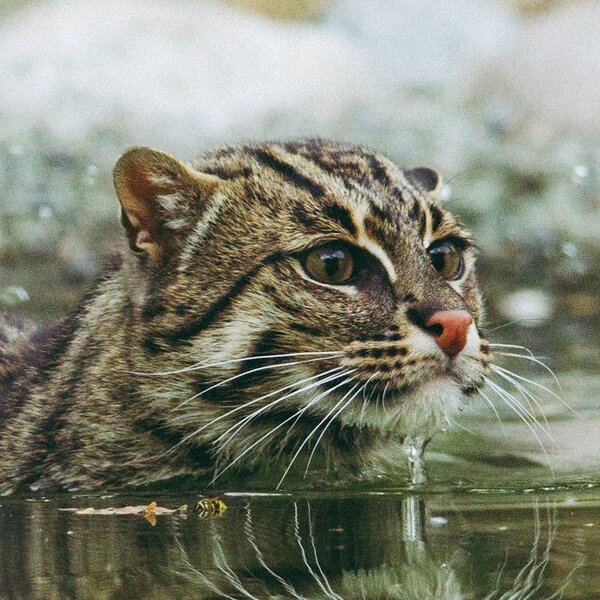
Flat-headed cats range from 16 to 20 inches in length, making them one of the smaller swimming wild cats.
Leopard cats are another small wild cat that is highly proficient in swimming. Found throughout Southeast and Southern Asia, these cats are often seen near rivers and lakes, where they hunt for fish and small mammals. Their webbed toes make swimming easier, allowing them to navigate across rivers and streams. Leopard cats are agile swimmers and use their skills to hunt for prey and travel across water barriers.
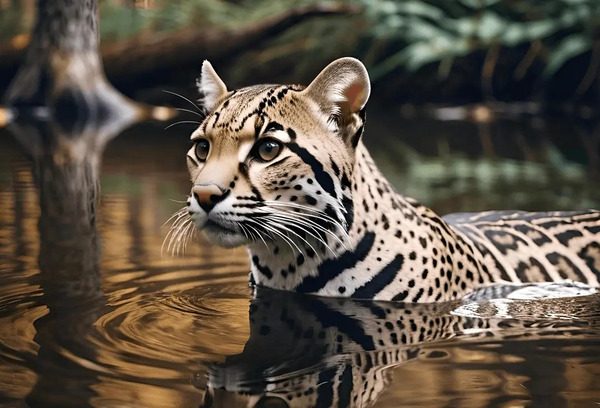
Leopard cats are typically between 18 and 28 inches in length and are skilled swimmers, often crossing water to reach new hunting grounds.
Geoffroy’s cat, native to South America, is another small wild cat known for its swimming abilities. These cats live in areas with abundant water sources, where they hunt for fish and amphibians. Geoffroy’s cats are often observed swimming across fast-flowing rivers and are considered to be highly skilled swimmers among the small wild cats.
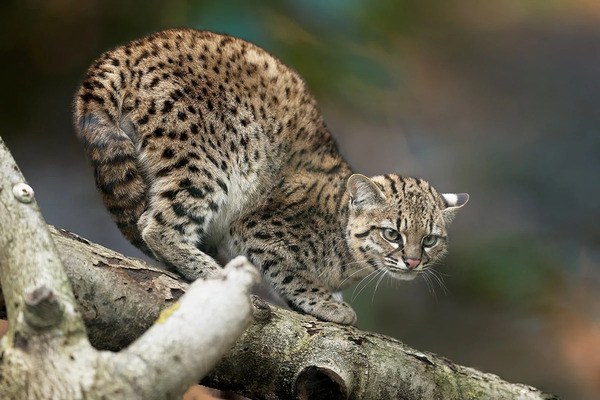
Geoffroy’s cats typically range from 20 to 24 inches in length and are agile swimmers that thrive in aquatic environments.
The rusty-spotted cat, one of the smallest wild cats in the world, is found in India and Sri Lanka. Though they are tiny, these cats are skilled swimmers and can often be seen near water sources. While their small size limits the extent to which they can swim, rusty-spotted cats are capable swimmers and will sometimes dive into the water to hunt for small prey.
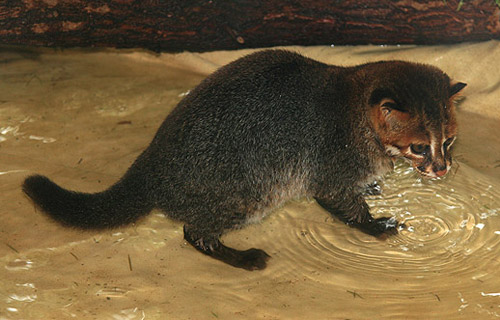
Rusty-spotted cats measure only 14 to 19 inches in length, making them one of the smallest wild cats to demonstrate swimming abilities.
The black-footed cat, native to Southern Africa, is a small, highly skilled predator. While they are not primarily aquatic, black-footed cats will occasionally swim to cross rivers and streams. Known for their stealth and agility, these cats will use their swimming abilities to escape threats or travel across their territories.
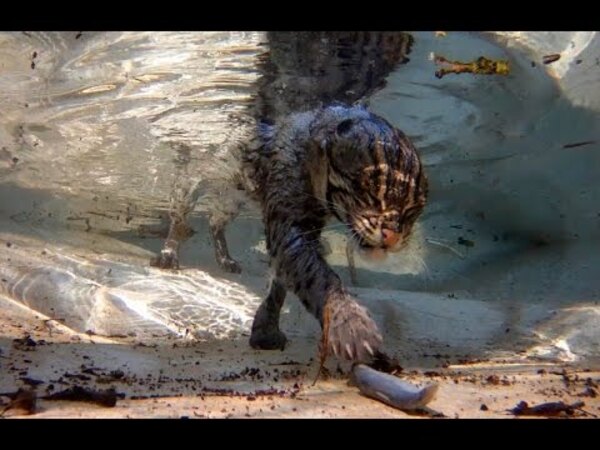
Black-footed cats range from 19 to 22 inches in length and are known for their incredible hunting skills, both on land and in water.
Here's a table summarizing the 15 wild cats that are known for their swimming abilities:
| No. | Wild Cat | Scientific Name | Habitat | Swimming Abilities | Size |
|---|---|---|---|---|---|
| 1 | Tiger | Panthera tigris | Southern Asia, China, Eastern Russia | Skilled swimmers, swim long distances, and even across islands. Known for hunting in water. | 6-10 feet long, 220-600 lbs |
| 2 | Jaguar | Panthera onca | Americas (19 countries) | Excellent swimmers, hunt in water, including caimans, fish, and turtles. | 5-8 feet long, 80-350 lbs |
| 3 | Leopard | Panthera pardus | Africa, India, Southeast Asia, and more | Swim across rivers, hunt in water (fish and crabs). | 36–72 inches long |
| 4 | Lion | Panthera leo | Africa, India | Occasional swimmers when crossing rivers or streams. | 5.6-8.3 feet long, 330-570 lbs |
| 5 | Cheetah | Acinonyx jubatus | Africa, Iran | Will swim when necessary, especially to cross rivers. | 3.5-5 feet long, 50-160 lbs |
| 6 | Clouded Leopard | Neofelis nebulosa | Southeast Asia, South China | Good swimmers, use swimming to navigate across rivers, excellent climbers. | 26–41 inches long |
| 7 | Fishing Cat | Prionailurus viverrinus | Southeast Asia, South Asia | Excellent swimmers, dive underwater to catch prey like fish, frogs, and reptiles. | 33–45 inches long |
| 8 | Jaguarundi | Herpailurus yagouaroundi | Central and South America | Skilled swimmers, dive to catch fish and amphibians, live in wetland areas. | 21–30 inches long, 12-20 inch tail |
| 9 | Ocelot | Leopardus pardalis | Southern USA, Mexico, Central and South America | Can swim in rivers, hunt for fish and frogs. | 29–39 inches long |
| 10 | Serval | Leptailurus serval | Sub-Saharan Africa | Competent swimmers, hunt frogs, birds, and small mammals in wetlands and near water. | 21–24 inches tall, 39–51 inches long |
| 11 | Flat-Headed Cat | Prionailurus planiceps | Southeast Asia (Thailand, Borneo) | Excellent swimmers, found in swamps, flooded forests, and streams, prey on fish and frogs. | 16–20 inches long |
| 12 | Leopard Cat | Prionailurus bengalensis | Southeast and South Asia | Skilled swimmers, often near water, hunt fish and small mammals, have webbed toes. | 18–28 inches long |
| 13 | Geoffroy’s Cat | Leopardus geoffroyi | South America | Known for swimming across rivers, hunt fish and amphibians, live near wetlands. | 20–24 inches long |
| 14 | Rusty-Spotted Cat | Prionailurus rubiginosus | India, Sri Lanka | Tiny, but capable swimmers, sometimes seen near water hunting small prey. | 14–19 inches long |
| 15 | Black-Footed Cat | Felis nigripes | Southern Africa | Not regular swimmers, but capable when necessary. Known for being highly efficient hunters. | 16–22 inches long |
Tigers, Jaguars, and Leopards are particularly notable for their strong swimming abilities, capable of swimming across large bodies of water and even hunting in the water.
Fishing Cats, Clouded Leopards, and Ocelots are known to live in or near aquatic environments and have evolved specialized features like webbed paws to help them navigate and hunt in the water.
Smaller cats like the Leopard Cat, Flat-Headed Cat, and Geoffroy’s Cat are also skilled swimmers, typically using their abilities to hunt in wetlands or navigate across rivers.
These wild cats demonstrate the impressive adaptability of the Felidae family to diverse environments, from dense jungles to vast savannahs, all with the added skill of being capable swimmers.
Wild cats that swim exhibit remarkable adaptability to their environments. Whether it's tigers, jaguars, or smaller cats like the leopard cat, many wild felids rely on water for hunting, traveling, or cooling off. These swimming skills provide them with an advantage in diverse habitats, from dense rainforests to vast wetlands. Understanding the swimming habits of these fascinating animals highlights the incredible diversity within the Felidae family and their ability to thrive in aquatic environments.
animal tags: cats
We created this article in conjunction with AI technology, then made sure it was fact-checked and edited by a Animals Top editor.